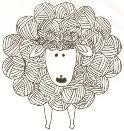When Mr S and I are away from home we often visit the local charity shops - Mr S looks for books - on railways, wood turning and fiction by his favourite authors, although the last one is getting harder as his collection grows! The best shops have the books stacked in alphabetical order which gets his approval and means that we spend less time browsing which is good for me. Up to now I have really only looked for sheepy things, but latterly I have started looking for hand-knitted garments.
This new search began after reading about the yarn bargains that can be found in these shops, particularly things made with expensive yarns being sold for what can only be called a pittance. From our recent stroll around the Charity shops in Halifax I have come to the conclusion that the sorters have got wise to this and think you are now less likely to find a yarn bargain than in the past.
I did, however, find a 100% wool tunic, hand-knitted in a rather nice heather green which I felt was worth the £3 price tag! But now I come to the bit that I find really quite extraordinary - the way this garment had been constructed!
Had I realised the quirky construction I would have taken photos, but it wasn't until I came to unravel the front that it came to light! The bottom half of the tunic was knitted in a knit2, purl2 rib, with a stocking stitch top. Obviously the knitter had realised after about 7 inches of ribbing that it was coming out too small. Now if I had been knitting this, I would have frogged and started again with more stitches - not the knitter of this particular garment.
As I unraveled the top of the ribbing I came upon what I thought at first to be some short row shaping. Closer inspection revealed that the first and last four stitches were knitted from the top down! As I continued with the deconstruction I found that the knitter had added the extra stitches around a section of ribbing.
The extra edge stitches had been knitted down until they came to the cast-on, on this row they had grafted the new knitting to the bottom of the tunic and knitted downwards! In this diagram the arrows show the direction of the stitches.
Effectively encasing the original ribbing - and it had been beautifully done, not really noticeable unless you looked really hard. I just can't believe that all that work was quicker than re-knitting a section of ribbing!
Also every join was knotted it didn't matter whether it was in the middle of a row, just a tiny knot with the ends cut off close - Mr S says that it is Yorkshire thrift!
So for the princely sum of £3 I got 650grams of Yorkshire wool and a lesson in garment construction - what a bargain!







No comments:
Post a Comment
Note: only a member of this blog may post a comment.